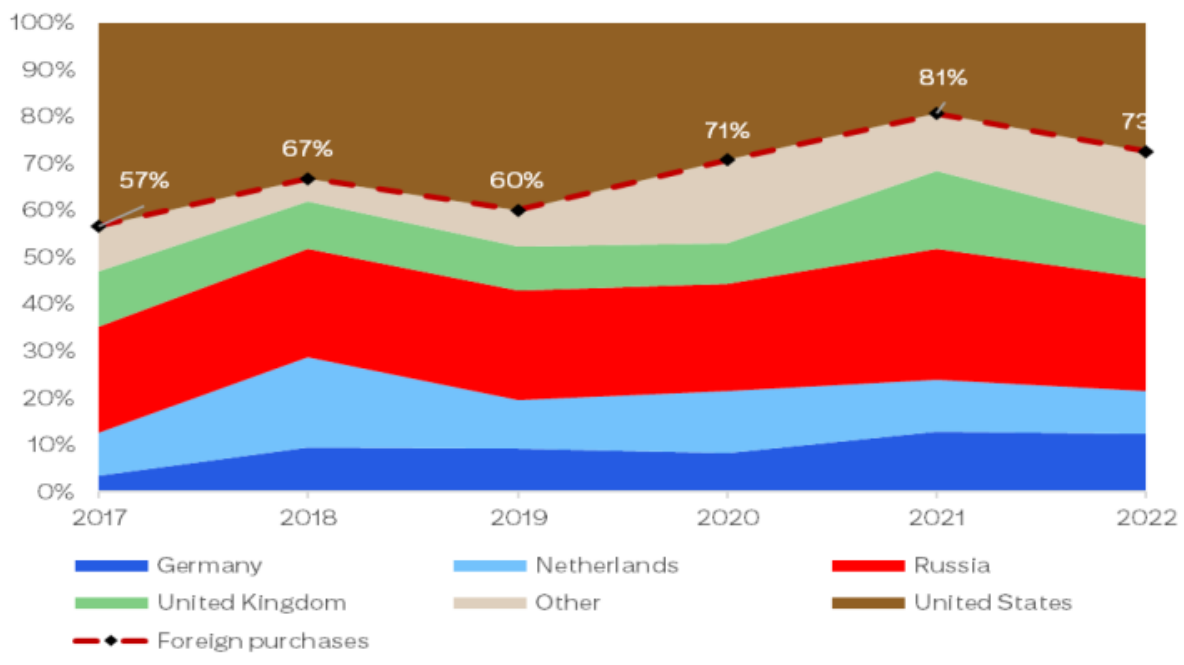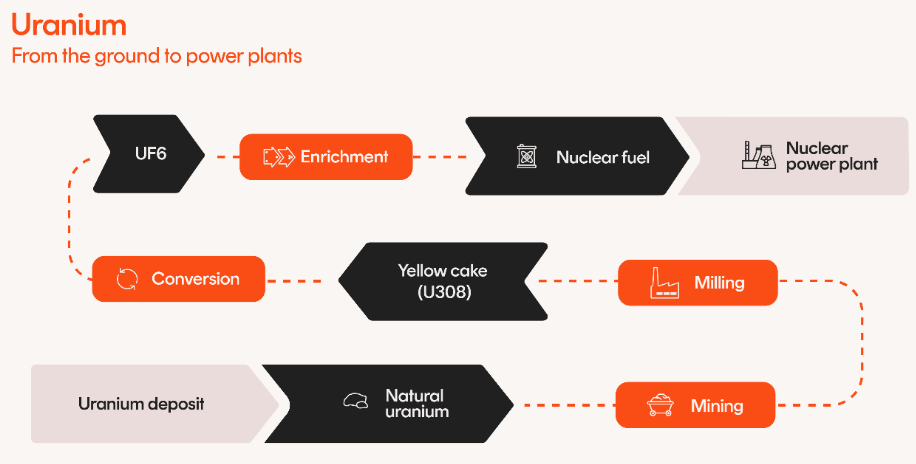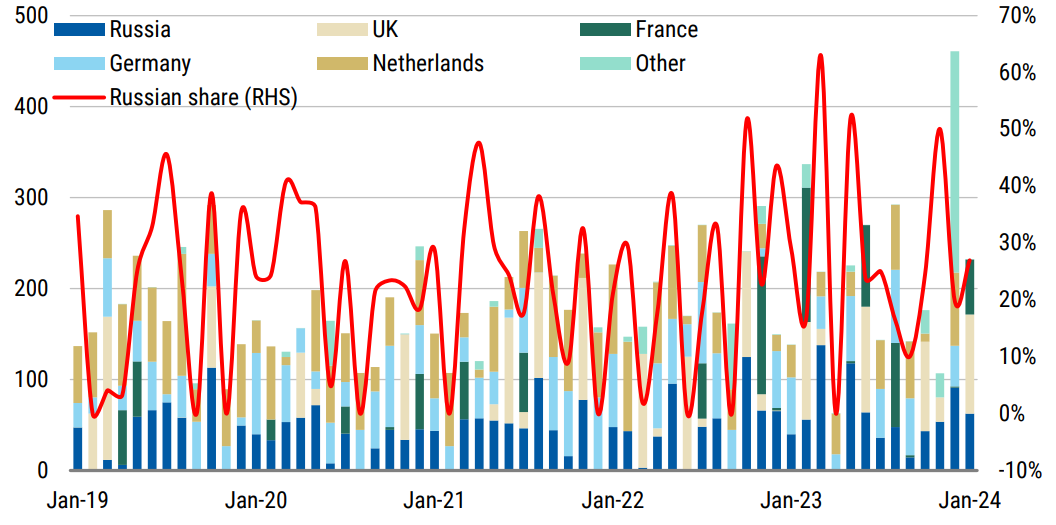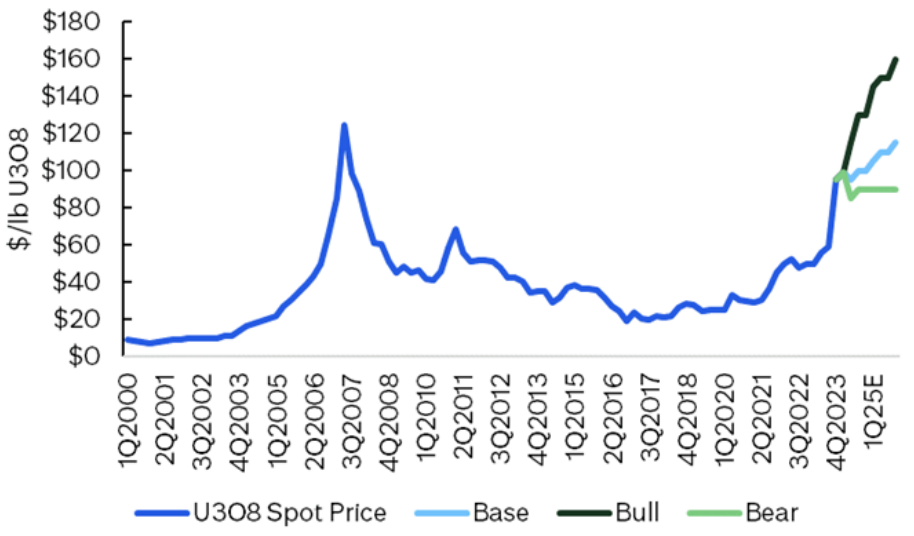How the Russian uranium ban will impact ASX uranium stocks
This week, news broke that the US Senate passed the Prohibiting Russian Uranium Imports Act. The Act is widely expected to be signed into law by President Biden within the next few weeks. If it is, it would ban all uranium supplies from Russia after 90 days from enactment.
According to the World Nuclear Association (WNA), Russia has substantial economic resources of uranium, with about 9% of the world’s reasonably assured resources. Just before it invaded Ukraine, it was the world’s sixth-largest producer of raw uranium, responsible for about 5.5% of global raw uranium production.
When assessing the impact of this ban on the uranium market and, therefore, on the uranium price, it's important to understand that the US imports only a small portion of its uranium requirements as uranium oxide (U3O8). Of these imports, Russia accounted for just 12%, with the bulk coming from Canada and Kazakhstan.
The bulk of the US’s nuclear power-related imports are of enriched uranium products, and here, Russia is responsible for about 33% of US imports, with state-owned Rosatom responsible for about 20% of US imports in its own right. So, when we talk about the US ban on Russian uranium, we’re really talking about a ban on enriched uranium products.

There’s a potential loophole built into the legislation to allow imports of Russian enriched uranium products if the US Department of Energy (DOE) determines that "no alternative viable source of low-enriched uranium is available to sustain the continued operation of a nuclear reactor or a US nuclear energy company" or if it’s in the national interest. These waivers aren’t permanent, though, and must terminate by 2028.
Market Impact
You’re probably wondering how what's effectively a ban on imports of Russian enriched uranium is going to impact your average Australian uranium stock like Paladin Energy (ASX: PDN), Boss Energy (ASX: BOE), Deep Yellow (ASX: DYL), Bannerman Energy (ASX: BMN), etc., which each aim to produce U3O8.
Okay, this is a bit complicated, and given that neither of us possess a degree in nuclear physics, I’ll do my best to get us to the point where we both understand the intricacies of this conundrum!
U3O8 must first be converted to UF6 (i.e., the “conversion process”), which is the key material in the enrichment process. Enriched uranium is uranium dioxide (UO2) which is pressed into pellets and bundled together to create a fuel assembly used in a nuclear reactor.

The gist of the US’s ban is this. US nuclear power utilities must now find another source for a big chunk of its fuel supplies. Non-Russian nuclear fuel players must now step up their production of enriched uranium to fill the gap. In theory, this should require greater supplies of UF6, and therefore U3O8.
The balance point between a modest versus a massive impact U3O8 demand depends on whether enrichers switch from underfeeding to overfeeding the centrifuges used in the enrichment process.
The prevailing state of the enrichment market prior to Russia’s invasion of Ukraine was one of overcapacity, allowing enrichers to underfeed their centrifuges. Underfeeding is a more efficient and lower-cost method of converting UF6 to UO2. It requires less UF6 feedstock, which is processed over longer periods to extract the maximum amount of obtainable end material.
Here's the interesting bit. If Non-Russian enrichers suddenly find themselves struggling to meet demand from US nuclear power utilities, they may be forced to switch to overfeeding. Overfeeding involves dumping in a great deal more UF6 and running your centrifuge faster, and therefore for a shorter period of time, to end up with the same amount of end material that less UF6 could produce over a longer period of time in an underfeeding scenario.
Enrichers hate overfeeding because the process is so much less efficient, and therefore significantly more costly. On the other hand, substantially greater UF6 demand means substantially greater U3O8 demand, and that’s where our Aussie uranium producers, explorers, and developers come in.
There you go. Mystery solved! (Note, it's also worth checking out Silex Systems (ASX: SLX) which is trying to commercialise its uranium enrichment technology).
Broker response
Two brokers we monitor have released research reports specifically on the Senate's passage of the Prohibiting Russian Uranium Imports Act.
In its report, Morgan Stanley focussed on the Non-Russian enrichment capacity angle, noting Russia’s 43% dominating share of the market. The broker suggests that Western enrichment capacity, which is about 41% of the total global market, would indeed likely lead to overfeeding to meet increased demand from US customers. This would, in turn, boost the demand for U3O8.
.%20Source%20Morgan%20Stanley%20Research,%20Trademap.png)
“The announcement is positive for uranium prices in our view”, notes Morgan Stanley, but it is likely to be “manageable” for the nuclear industry. Things get really juicy, suggests the broker, if the EU/UK also joined in. Morgan Stanley predicts this scenario “would cover 55% of demand needing to be supplied by 41% of enrichment capacity, putting pressure on supply”.
Citi also feels a US ban on Russian uranium imports taking effect will support the price of U3O8. “The Russian nuclear fuel ban in the US is a definite tailwind for uranium prices”, it said in its research report on the topic. Citi believes the uncertainty the ban creates will add to an “already volatile environment”, and that this would help “keep uranium prices elevated for longer”.
Citi’s price target for U3O8 is US$95/lb by the middle of this year, but their base case is for it to increase to US$100/lb by the end of the year. FYI, The current U3O8 spot price at the time of writing is US$92.25/lb.

In the longer term, Citi is even more bullish. The broker’s “base case” sees the U3O8 price rising to $115/lb in the next “2-3 years”, but strap in lithium bulls, in Citi’s “bull case”, they note the prospect of uranium prices “potentially breaching 2007’s highs of $146/lb”.
You get a special rocket ship emoji for that one Citi! 🚀
You may wish to check out these other articles I’ve written on the Uranium market and on ASX listed Uranium producers:
Rocket emojis aside, what's left in this ASX Uranium run?
A definitive guide to ASX uranium stocks: The top 5
This article first appeared on Market Index on Friday 3 May 2024.
5 topics
17 stocks mentioned

